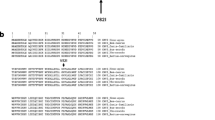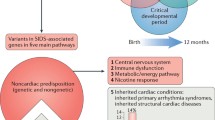Abstract
Sudden infant death syndrome is the unexpected demise of a child younger than 1 year of age which remains unexplained after a complete autopsy investigation. Usually, it occurs during sleep, in males, and during the first 12 weeks of life. The pathophysiological mechanism underlying the death is unknown, and the lethal episode is considered multifactorial. However, in cases without a conclusive post-mortem diagnosis, suspicious of cardiac arrhythmias may also be considered as a cause of death, especially in families suffering from any cardiac disease associated with sudden cardiac death. Here, we review current understanding of sudden infant death, focusing on genetic causes leading to lethal cardiac arrhythmias, considering both genes encoding ion channels as well as structural proteins due to recent association of channelopathies and desmosomal genes. We support a comprehensive analysis of all genes associated with sudden cardiac death in families suffering of infant death. It allows the identification of the most plausible cause of death but also of family members at risk, providing cardiologists with essential data to adopt therapeutic preventive measures in families affected with this lethal entity.
Similar content being viewed by others
References
Pritchard E (1918) Enlarged suprarenals and sudden death in an infant. Proc Royal Soc Med 11:35–36
Garrow I, Werne J (1953) Sudden apparently unexplained death during infancy. III. Pathologic findings in infants dying immediately after violence, contrasted with those after sudden apparently unexplained death. Am J Pathol 29:833–851
Werne J, Garrow I (1953) Sudden apparently unexplained death during infancy. II. Pathologic findings in infants observed to die suddenly. Am J Pathol 29:817–831
Werne J, Garrow I (1953) Sudden apparently unexplained death during infancy. I. Pathologic findings in infants found dead. Am J Pathol 29:633–675
Adelson L, Kinney ER (1956) Sudden and unexpected death in infancy and childhood. Pediatrics 17:663–699
Willinger M, James LS, Catz C (1991) Defining the sudden infant death syndrome (SIDS): deliberations of an expert panel convened by the National Institute of Child Health and Human Development. Pediatr Pathol / Affiliated Int Paediatr Pathol Assoc 11:677–684
Krous HF, Beckwith JB, Byard RW et al (2004) Sudden infant death syndrome and unclassified sudden infant deaths: a definitional and diagnostic approach. Pediatrics 114:234–238
Priori SG, Blomstrom-Lundqvist C, Mazzanti A et al. 2015 ESC Guidelines for the management of patients with ventricular arrhythmias and the prevention of sudden cardiac death: The Task Force for the Management of Patients with Ventricular Arrhythmias and the Prevention of Sudden Cardiac Death of the European Society of Cardiology (ESC)Endorsed by: Association for European Paediatric and Congenital Cardiology (AEPC). Eur Heart J 2015
Byard RW, Ranson D, Krous HF (2005) National Australian workshop consensus on the definition of SIDS and initiation of a uniform autopsy approach to unexpected infant and early childhood death. Forensic Sci, Med Pathol 1:289–292
Moon RY, Fu LY (2007) Sudden infant death syndrome. Pediatr Rev / Am Acad Pediatr 28:209–214
Froggatt P, Lynas MA, MacKenzie G (1971) Epidemiology of sudden unexpected death in infants (‘cot death’) in Northern Ireland. Br J Prev Soc Med 25:119–134
Wedgwood R. Sudden and unexpected deaths in infancy In: Sudden and Unexpected Death in Infancy Edited by: Camps FE CR. Bristol, England: Wright; 1972. pp. 22–28
Rognum TO, Saugstad OD (1993) Biochemical and immunological studies in SIDS victims. Clues to understanding the death mechanism. Acta Paediatr Suppl 82(Suppl 389):82–85
Filiano JJ, Kinney HC (1994) A perspective on neuropathologic findings in victims of the sudden infant death syndrome: the triple-risk model. Biol Neonate 65:194–197
Guntheroth WG, Spiers PS (2002) The triple risk hypotheses in sudden infant death syndrome. Pediatrics 110, e64
Malloy MH (2004) Sudden infant death syndrome among extremely preterm infants: United States 1997–1999. J Perinatol: Off J Calif Perinatal Assoc 24:181–187
Vege A, Rognum TO, Scott H et al (1995) SIDS cases have increased levels of interleukin-6 in cerebrospinal fluid. Acta Paediatr 84:193–196
Arnestad M, Andersen M, Vege A, Rognum TO (2001) Changes in the epidemiological pattern of sudden infant death syndrome in southeast Norway, 1984–1998: implications for future prevention and research. Arch Dis Child 85:108–115
Colvin JD, Collie-Akers V, Schunn C, Moon RY (2014) Sleep environment risks for younger and older infants. Pediatrics 134:e406–412
Moon RY (2011) SIDS and other sleep-related infant deaths: expansion of recommendations for a safe infant sleeping environment. Pediatrics 128:1030–1039
Moon RY, Tanabe KO, Yang DC et al (2012) Pacifier use and SIDS: evidence for a consistently reduced risk. Matern Child Health J 16:609–614
Moon RY, Horne RS, Hauck FR (2007) Sudden infant death syndrome. Lancet 370:1578–1587
Van Norstrand DW, Ackerman MJ (2010) Genomic risk factors in sudden infant death syndrome. Genome Med 2:86
Edwards WD (2005) Molecular autopsy vs postmortem genetic testing. Mayo Clin Proc 80:1234–1235, author reply 1235–1236
Tester DJ, Ackerman MJ (2006) The role of molecular autopsy in unexplained sudden cardiac death. Curr Opin Cardiol 21:166–172
Evans A, Bagnall RD, Duflou J, Semsarian C (2013) Postmortem review and genetic analysis in sudden infant death syndrome: an 11-year review. Hum Pathol 44:1730–1736
Tveten K, Strom TB, Cameron J et al (2012) Characterization of a naturally occurring degradation product of the LDL receptor. Mol Genet Metab 105:149–154
Kitamura R, Matsuoka K, Nagayama S, Otagiri M (2008) Time-dependent induction of rat hepatic CYP1A1 and CYP1A2 expression after single-dose administration of the anti-angiogenic agent TSU-68. Drug Metabol Pharm 23:421–427
Arnestad M, Crotti L, Rognum TO et al (2007) Prevalence of long-QT syndrome gene variants in sudden infant death syndrome. Circulation 115:361–367
Campuzano O, Allegue C, Sarquella-Brugada G et al (2014) The role of clinical, genetic and segregation evaluation in sudden infant death. Forensic Sci Int 242:9–15
Campuzano O, Sanchez-Molero O, Allegue C et al (2014) Post-mortem genetic analysis in juvenile cases of sudden cardiac death. Forensic Sci Int 245C:30–37
Anraku M, Fujii T, Furutani N et al (2009) Antioxidant effects of a dietary supplement: reduction of indices of oxidative stress in normal subjects by water-soluble chitosan. Food Chem Toxicol: Int J Published Br Ind Biol Res Assoc 47:104–109
Anraku M, Kitamura K, Shintomo R et al (2008) Effect of intravenous iron administration frequency on AOPP and inflammatory biomarkers in chronic hemodialysis patients: a pilot study. Clin Biochem 41:1168–1174
Courts C, Madea B (2010) Genetics of the sudden infant death syndrome. Forensic Sci Int 203:25–33
Sweeting J, Semsarian C. Cardiac Abnormalities and Sudden Infant Death Syndrome. Paediatric respiratory reviews 2014
Campuzano O, Allegue C, Partemi S et al (2014) Negative autopsy and sudden cardiac death. Int J Legal Med 128:599–606
Van Norstrand DW, Ackerman MJ (2009) Sudden infant death syndrome: do ion channels play a role? Heart Rhythm 6:272–278
Wang D, Shah KR, Um SY et al (2014) Cardiac channelopathy testing in 274 ethnically diverse sudden unexplained deaths. Forensic Sci Int 237:90–99
Gladding PA, Evans CA, Crawford J et al (2010) Posthumous diagnosis of long QT syndrome from neonatal screening cards. Heart Rhythm 7:481–486
Skinner JR, Crawford J, Smith W et al (2011) Prospective, population-based long QT molecular autopsy study of postmortem negative sudden death in 1 to 40 year olds. Heart Rhythm 8:412–419
Tester DJ, Ackerman MJ (2007) Postmortem long QT syndrome genetic testing for sudden unexplained death in the young. J Am Coll Cardiol 49:240–246
Tester DJ, Spoon DB, Valdivia HH et al (2004) Targeted mutational analysis of the RyR2-encoded cardiac ryanodine receptor in sudden unexplained death: a molecular autopsy of 49 medical examiner/coroner’s cases. Mayo Clin Proc 79:1380–1384
Tfelt-Hansen J, Winkel BG, Grunnet M, Jespersen T (2011) Cardiac channelopathies and sudden infant death syndrome. Cardiology 119:21–33
Ackerman MJ (2005) Cardiac causes of sudden unexpected death in children and their relationship to seizures and syncope: genetic testing for cardiac electropathies. Semin Pediatr Neurol 12:52–58
Morini E, Sangiuolo F, Caporossi D et al (2015) Application of next generation sequencing for personalized medicine for sudden cardiac death. Front Genet 6:55
Bagnall RD, Das KJ, Duflou J, Semsarian C (2014) Exome analysis-based molecular autopsy in cases of sudden unexplained death in the young. Heart Rhythm 11:655–662
Borsting C, Morling N. Next generation sequencing and its applications in forensic genetics. Forensic science international. Genetics 2015
Van Norstrand DW, Tester DJ, Ackerman MJ (2008) Overrepresentation of the proarrhythmic, sudden death predisposing sodium channel polymorphism S1103Y in a population-based cohort of African-American sudden infant death syndrome. Heart Rhythm 5:712–715
Brion M AC, Gil R, Torres M, Santori M, Poster S, Madea B, Carracedo A. Involvement of hypertrophic cardiomyopathy genes in sudden infant death syndrome (SIDS). Forensic Science International: Genetics Supplement Series 2009:495–496
Brion M, Allegue C, Santori M et al (2012) Sarcomeric gene mutations in sudden infant death syndrome (SIDS). Forensic Sci Int 219:278–281
Cerrone M, Delmar M (2014) Desmosomes and the sodium channel complex: implications for arrhythmogenic cardiomyopathy and Brugada syndrome. Trends Cardiovasc Med 24:184–190
Cerrone M, Lin X, Zhang M et al (2014) Missense mutations in plakophilin-2 cause sodium current deficit and associate with a Brugada syndrome phenotype. Circulation 129:1092–1103
Santori M, Blanco-Verea A, Gil R et al. Broad-based molecular autopsy: a potential tool to investigate the involvement of subtle cardiac conditions in sudden unexpected death in infancy and early childhood. Archives of disease in childhood 2015
Campuzano O, Allegue C, Fernandez A et al (2015) Determining the pathogenicity of genetic variants associated with cardiac channelopathies. Sci Rep 5:7953
Glengarry JM, Crawford J, Morrow PL et al (2014) Long QT molecular autopsy in sudden infant death syndrome. Arch Dis Child 99:635–640
Ackerman MJ, Siu BL, Sturner WQ et al (2001) Postmortem molecular analysis of SCN5A defects in sudden infant death syndrome. JAMA 286:2264–2269
Cronk LB, Ye B, Kaku T et al (2007) Novel mechanism for sudden infant death syndrome: persistent late sodium current secondary to mutations in caveolin-3. Heart Rhythm 4:161–166
Tester DJ, Dura M, Carturan E et al (2007) A mechanism for sudden infant death syndrome (SIDS): stress-induced leak via ryanodine receptors. Heart Rhythm 4:733–739
Larsen MK, Berge KE, Leren TP et al (2013) Postmortem genetic testing of the ryanodine receptor 2 (RYR2) gene in a cohort of sudden unexplained death cases. Int J Legal Med 127:139–144
Otagiri T, Kijima K, Osawa M et al (2008) Cardiac ion channel gene mutations in sudden infant death syndrome. Pediatr Res 64:482–487
Millat G, Kugener B, Chevalier P et al (2009) Contribution of long-QT syndrome genetic variants in sudden infant death syndrome. Pediatr Cardiol 30:502–509
Andreasen C, Refsgaard L, Nielsen JB et al (2013) Mutations in genes encoding cardiac ion channels previously associated with sudden infant death syndrome (SIDS) are present with high frequency in new exome data. Can J Cardiol 29:1104–1109
Wilders R. A note on the prevalence of cardiac ion channelopathies in the sudden infant death syndrome. Europace 2015
Lopez HU, Haverfield E, Chung WK. Whole Exome Sequencing Reveals CLCNKB Mutations in a Case of Sudden Unexpected Infant Death. Pediatric and developmental pathology : the official journal of the Society for Pediatric Pathology and the Paediatric Pathology Society 2015
Wong LC, Roses-Noguer F, Till JA, Behr ER (2014) Cardiac evaluation of pediatric relatives in sudden arrhythmic death syndrome: a 2-center experience. Circ Arrhythm Electrophysiol 7:800–806
van der Werf C, Stiekema L, Tan HL et al (2014) Low rate of cardiac events in first-degree relatives of diagnosis-negative young sudden unexplained death syndrome victims during follow-up. Heart Rhythm 11:1728–1732
Morris JA (2015) The genomic load of deleterious mutations: relevance to death in infancy and childhood. Front Immunol 6:105
Acknowledgments
No funding was secured for this study.
Author information
Authors and Affiliations
Corresponding author
Ethics declarations
Conflict of interest
The authors declare that they have no conflict of interest.
Additional information
Georgia Sarquella-Brugada and Oscar Campuzano contributed equally to this work.
Rights and permissions
About this article
Cite this article
Sarquella-Brugada, G., Campuzano, O., Cesar, S. et al. Sudden infant death syndrome caused by cardiac arrhythmias: only a matter of genes encoding ion channels?. Int J Legal Med 130, 415–420 (2016). https://doi.org/10.1007/s00414-016-1330-7
Received:
Accepted:
Published:
Issue Date:
DOI: https://doi.org/10.1007/s00414-016-1330-7




